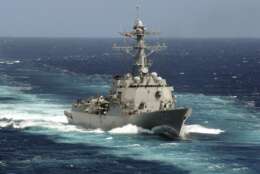On DoD
-
Major reductions in military accessions, a civilian hiring freeze and cuts to PCS moves are all strong possibilities under a full-year continuing resolution, Defense leaders testified Wednesday.
January 13, 2022 -
After years of cost overruns and vessel accidents, the Navy is rethinking leadership.
January 12, 2022 -
OPM is creating a Chief Diversity Officer Council and exploring the possibility of creating a job classification series for federal employees who work as diversity experts.
January 12, 2022 -
Neither drones nor autonomous ships, unmanned surface vessels, or USVs, will form an important part of the Navy’s strategy of expanding its fleet in a way that’s lower cost, relative to manned ships, and more agile.
January 12, 2022 -
Defense agencies have utilized strategies to address attack vectors and build a workforce that can block ransomware as the federal government transitions toward storing its data in the cloud.
January 12, 2022 -
To date, thousands of families have been displaced by jet fuel in drinking water.
January 11, 2022 -
The Defense Information Systems Agency’s new strategic plan details a policy change in the way the agency will buy and manage cloud services under the JWCC program.
January 10, 2022 -
The increase marks the highest health alert at the Pentagon since the end of 2020.
January 07, 2022 -
The agency is also looking to take better advantage of an “explosion” in commercial earth data.
January 06, 2022 -
The program has grants between $500 and $1,500.
January 06, 2022 -
Over the past few years, the Pentagon has spent $8 billion on contractors to supply planes and pilots to play enemy. Now those contracts are under review.
January 06, 2022 -
The Navy said on Dec. 15 it plans to discharge sailors not in compliance.
January 04, 2022 -
The Electromagnetic Spectrum Enterprise Policy and Program Office in the DoD’s office of the chief information officer launched a new program to improve communication with industry about spectrum sharing.
January 04, 2022 -
The small market organization will encompass 140 military hospitals and clinics.
January 03, 2022 -
The Pentagon said it's streamlined the approval process for urgent use of National Guard forces in the District of Columbia.
December 30, 2021














